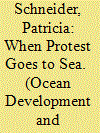| Srl | Item |
| 1 |
ID:
175493


|
|
|
|
|
| Summary/Abstract |
This article examines the Brazilian interpretation and application of Article 121 of the United Nations Convention on the Law of the Sea (UNCLOS) through analysis of the St. Peter and St. Paul insular features, historically considered as a group of rocks. Prior to the entry into force of UNCLOS, Brazil implemented a three-step process to change the legal status of these features in order to claim an exclusive economic zone and continental shelf. More recently, Brazil has strengthened its basis of claim through the employment of straight baselines and the establishment of a large-scale marine protected area around St. Peter and St. Paul. It is argued that Brazil has used a flexible understanding of the human habitation requirement and relied on debatable state practice in order to maximize its maritime areas around these features.
|
|
|
|
|
|
|
|
|
|
|
|
|
|
|
|
| 2 |
ID:
175494


|
|
|
|
|
| Summary/Abstract |
China and North Korea have delimited the boundary of their territorial seas by signing a 1962 Border Treaty and a 1964 Border Protocol, but the two states still need to delimit the boundary of their exclusive economic zones (EEZs) and continental shelves (CSs) in the North Yellow Sea (NYS). Considering the geographical characteristics of the two states’ coasts in the NYS, this article proposes that China and North Korea can delimit a single maritime boundary for the EEZ and the CS by applying the equidistance/relevant circumstances method, and then following a “three-stage approach.” The first stage is to construct a provisional equidistance line in the NYS; the second stage is to adjust the provisional equidistance line in light of relevant circumstances, such as the partial effect of Nan Tuozi in light of its distance from the coast of the continent; and the third stage is to apply the disproportionality test to the maritime area allocated to the two states in the NYS. After applying the “three-stage approach” to this case, the author concludes that the potential delimitation line of EEZ/CS between the two states extends generally south-southwest through seven segments for a distance of about 196 km (106 nm). Since 2018, tensions appear to have declined on the Korean Peninsula, and this may provide an opportunity for China and North Korea to start their maritime boundary delimitation negotiation in the near future.
|
|
|
|
|
|
|
|
|
|
|
|
|
|
|
|
| 3 |
ID:
175492


|
|
|
|
|
| Summary/Abstract |
This article examines the development of case law concerning the criteria determining the relevant coasts and the relevant areas in delimitation of the exclusive economic zone and continental shelf. There is a discrepancy in the jurisprudence over whether the relevant area is determined by assessing the overlaps of “seaward extension,” “projections,” or “potential entitlement,” and this undermines the transparency of the process and the predictability of the result. There is also a debate over whether identification of the relevant area shall be based on “frontal” or “radial” projections. This article tracks this jurisprudence, questions why there is a discrepancy, and critically analyzes the consequences of these decisions in the light of the principle of equity.
|
|
|
|
|
|
|
|
|
|
|
|
|
|
|
|
| 4 |
ID:
175491


|
|
|
|
|
| Summary/Abstract |
The article applies social movement theory to piracy and terrorism as a common conceptual roof, contextualizing and theorizing these phenomena. The cases of Nigeria and Somalia were chosen because pirate and terrorist groups are or have been active in the maritime domain in both countries, posing a problem for the international shipping community. In addition, these cases are special insofar as pirate and terrorist groups in these countries have used powerful narratives to underpin an attitude of social protest to legitimize their violence. The article critically examines whether the characteristics and modes of social movement theory apply to these cases and outlines the possible benefits and limits. It further includes perspectives from other conceptual frameworks from philosophy, sociology, and psychology. The analysis concludes that the concepts can add to our understanding of the phenomena of maritime violence. It helps us to view these groups not merely as risk factors and addressees of security governance but through the lens of social protest and the mechanisms and dynamics outlined by social movement theory.
|
|
|
|
|
|
|
|
|
|
|
|
|
|
|
|